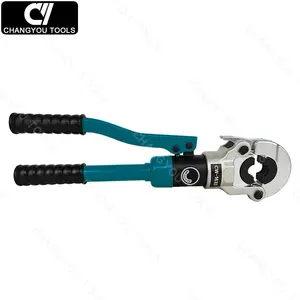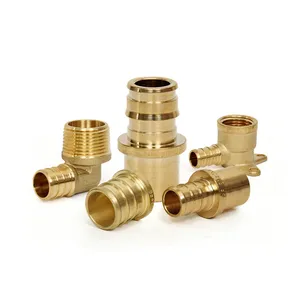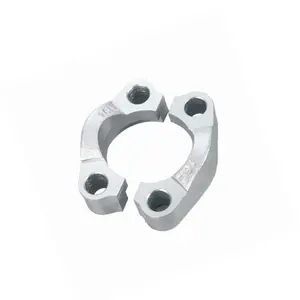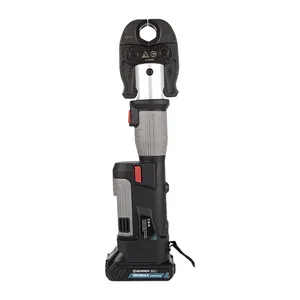Introduction
In the ever-evolving world of plumbing, the tools of the trade are constantly being upgraded and refined. One such tool that has revolutionized the industry is the pipe crimping tool. This article delves into the basics of plumbing, the role of pipe crimping tools, and the different types available, including manual, battery-powered, and hydraulic. We'll also explore how to use these tools effectively and safely, their impact on modern plumbing, and real-world case studies that demonstrate their transformative power. Prepare to discover how these tools are changing the game in plumbing, making jobs faster, cleaner, and more efficient.
Understanding Plumbing Basics
Plumbing follows the basic laws of nature — gravity, pressure, and water seeking its own level. The plumbing system in your home is composed of two separate subsystems. One subsystem brings freshwater in, and the other takes wastewater out. The water that comes into your home is under pressure, allowing it to travel upstairs, around corners, or wherever else it's needed. In a plumbing emergency, it's vital to quickly close the main shutoff valve. Most fixtures should have individual stop valves. The supply and drainage subsystems are two distinct operations, with no overlapping between them.
The Role of Pipe Crimping Tools in Plumbing
Pipe crimping tools play a crucial role in plumbing, especially when working with multilayer tubes. These tools ensure a professional quality crimp, providing a secure and tight connection. They come with different jaws like TH & U jaws, suitable for various applications. Similarly, the Multi-layered Pipe Crimping Tool Kit offers optimal results with its compression tightening feature. These tools are designed for professional use, guaranteeing quality and efficiency in plumbing work.
Different Types of Pipe Crimping Tools
Pipe crimping tools are essential for any plumbing job, and they come in various types to suit different needs. The single-size tools are designed for a specific size of pipe, ensuring a perfect crimp every time. Dual-size tools, on the other hand, offer more versatility as they can accommodate two different pipe sizes. For a more comprehensive solution, PEX Crimp Tool Kits are available, which include multiple tools for various pipe sizes. Lastly, there's the Decrimper, a specialized tool used for removing crimp rings without damaging the pipe.
Manual Crimping Tools
Manual crimping tools are often sufficient for smaller crimping requirements where precision is key. They are designed to work with particular cable, wire, or pipe sizes, and some models can work with several. These tools are multifunctional, offering compression alongside bending, cutting, stripping, and similar actions. Manual crimp tools are typically used to create a firm and reliable bond, making them an essential tool in various industries and environments.
Battery-Powered Crimping Tools
Battery-powered crimping tools are a popular choice for modern plumbing tasks. For instance, there are 18-Volt and 12-Volt Lithium-Ion Brushless Cordless Press Tools available in the market. They come in various kits, some including jaws and batteries. These tools are designed for efficiency and ease of use, making them a valuable asset in any plumber's toolkit.
Hydraulic Crimping Tools
Hydraulic crimpers, also known as hydraulic crimping tools, are used to connect the ends of flexible materials like hoses. They work by using pressurized liquid to drive a piston into a cylinder, compressing a die against the material being worked on. This forms a permanent bend at the point of contact. The key component in the system which creates the crimping itself is called the crimp head. These tools are ideal for large-scale production lines where manual labour costs are high, automating the process to reduce downtime due to errors.
How to Use a Pipe Crimping Tool Effectively
To use a pipe crimping tool effectively, first select the proper terminal for the application and wire size. Strip the wire to the proper length and select the appropriate crimp tool. Choose the correct crimp pocket for the terminals and wire size. If crimping stranded wire, twist the strands together for easier insertion into the connector. Insert the bare wire end into the connector, ensuring it contacts the metal portion. Match the color on the crimping tool to the connector's color, squeeze hard, and wrap the connection with electrical tape for added security if desired.
Safety Measures When Using Pipe Crimping Tools
When using pipe crimping tools, safety is paramount. To minimize injury risks, identify and implement Safety Zones around the crimp dies, including an Exclusion Zone and a Caution Zone. The Exclusion Zone represents areas with a direct risk of crushing injury, so keep hands and tools clear. The Caution Zone has minimal injury potential, but caution is still advised. Also, ensure the tool is regularly inspected and maintained for safe operation. If the tool shows signs of erratic operation, remove it from service immediately.
The Impact of Pipe Crimping Tools on Modern Plumbing
The introduction of a system of joining copper pipes without soldering has revolutionized modern plumbing. This method, using a special pressing tool to crimp fittings onto pipes, is faster, cleaner, and more reliable than traditional soldering. It drastically reduces the time spent on a job, ensures a cleaner workspace, and provides a watertight and highly resistant connection. This advancement aligns perfectly with the industry's commitment to efficiency and effectiveness.
Case Studies: Revolutionizing Plumbing with Pipe Crimping Tools
In a residential plumbing service job, a plumbing company used push-to-connect fittings to run a new water line to a customer’s crawl space for a new garden spigot. The use of push-to-connect fittings allowed for efficient installation without waiting for solvent weld fittings to cure. This resulted in a quality installation that was completed in three hours, reducing the typical on-site time by about two hours. This case study exemplifies the revolutionizing impact of modern plumbing tools like pipe crimping tools on service speed and quality.
Conclusion
The pipe crimping tool has undeniably revolutionized the plumbing industry. Its various types, including manual, battery-powered, and hydraulic, cater to different needs and applications. The tool's effective use and safety measures ensure a secure and efficient work environment. The advent of a system for joining pipes without soldering and the use of crimping tools have made plumbing tasks faster, cleaner, and more reliable. Case studies highlight the significant impact of these tools, reducing on-site time and improving service quality. As we continue to embrace these advancements, the future of plumbing looks promising, with increased efficiency and effectiveness at its core.











































 浙公网安备 33010002000092号
浙公网安备 33010002000092号 浙B2-20120091-4
浙B2-20120091-4